Since nose is the most protruding organ on our face, the shape of the nose is one of the most determining factors of the general character and elegance of the face. A slight deformity in the nose can be easily noticed. Even some minor corrections to the nose can change the facial appearance a lot.
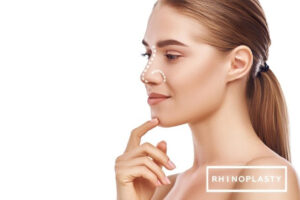 The upper part of the nose consists of the bone and the lower part of cartilage tissue. Likewise, the part of the nose called the ‘septum’, which is the partition that divides the inner cavity of the nose into two, consists of bone at the top and cartilage at the bottom.
The upper part of the nose consists of the bone and the lower part of cartilage tissue. Likewise, the part of the nose called the ‘septum’, which is the partition that divides the inner cavity of the nose into two, consists of bone at the top and cartilage at the bottom.
Nose surgery, also known as ‘Rhinoplasty’ is a type of surgery that reshapes the nose by changing the structures of bone and/or cartilage tissues. One or all of these changes can be performed in a single session. The aim of rhinoplasty is to increase the harmony of the face and nose. It also helps to eliminate respiratory problems if any exits. Rhinoplasty aims not only for an ideal nose, but also for a nose that is compatible with the other features of the face.
When planning nose surgery, the skin structure, racial characteristics and age of the person are taken into consideration. It is also evaluated whether there are any conditions that make breathing difficult before rhinoplasty. Additional cosmetic interventions such as chin augmentation may also be planned for a better facial appearance.
Rhinoplasty Techniques
There are 2 types of procedures used for rhinoplasty:
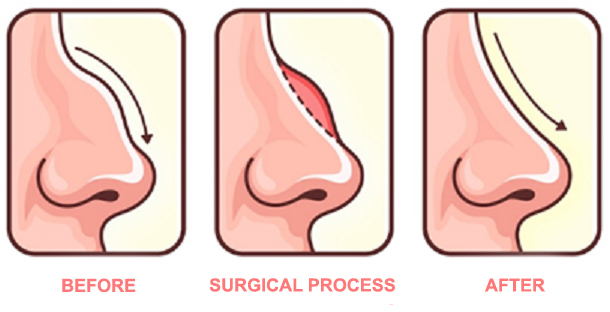 ‘Open Rhinoplasty’ and ‘Closed Rhinoplasty’. Both procedures have their own advantages. In general, closed rhinoplasty is preferred if minimal changes will be made in the nose, and open rhinoplasty is preferred if radical changes will be made.
‘Open Rhinoplasty’ and ‘Closed Rhinoplasty’. Both procedures have their own advantages. In general, closed rhinoplasty is preferred if minimal changes will be made in the nose, and open rhinoplasty is preferred if radical changes will be made.
Open Rhinoplasty
Open rhinoplasty is preferred in cases where there are problems such as curvature of the nasal septum that will make breathing difficult and in cases with advanced deformities in the nose. This type of surgery is performed by making an incision in the zone between the nostrils. Even if you have open rhinoplasty, there will be no obvious surgical scars on your face. Immediately after the surgery, there may be partial swelling in the nose, but this is not caused by the procedure itself, but by the radical changes made to your nose.
Closed Rhinoplasty
In closed rhinoplasty, no intervention is performed from outside of the nose, including the area between the nostrils. All changes are made by entering the nasal cavity through the nostril opening. After closed rhinoplasty, there is absolutely no scar on the nose.
Ultrasonic Rhinoplasty
Instead of metal surgical instruments used to change the nasal bone and cartilage structure during rhinoplasty, motor systems have been started to be used as an alternative today. The process of cutting and shaping the nasal bone and cartilage with very thin pen-like instruments without damaging the soft tissues is called ‘Ultrasonic Rhinoplasty’. Since the bones are cut in a more controlled manner, the nose ends up looking more elegant and natural. However, it is a method that can only be applied during open rhinoplasty. Almost all patients are suitable candidates for ultrasonic rhinoplasty.
 Nose Tip Plastic Surgery: Tip Plasty
Nose Tip Plastic Surgery: Tip Plasty
If the deformity is only at the tip of the nose and cartilage structure, the operation to be performed is ‘Tip Plasty’. Tip plasty is applied to people who do not have problems with the nasal bone and are only bothered by the width or height of nasal tip. It is possible to achieve natural rhinoplasty results with tip plasty.
Non-Surgical Rhinoplasty
For various reasons people may not want to have rhinoplasty. In this case, curvatures, indentations and protrusions that cause mild deformities in the nose can be hidden with fillers and/or botox applications, and low nasal tips can be corrected. This procedure is called ‘Non-Surgical Rhinoplasty’. Thus, you can have an aesthetic nose without the need for surgical intervention, without anesthesia, with an application which lasts about 20-30 minutes.
What is rhinoplasty?
Rhinoplasty is the most commonly performed cosmetic surgery in the world. Rhinoplasty is a cosmetic and functional operation performed to eliminate congenital, acquired or trauma-related deformities in the nose and to ensure harmony between the face and nose. It also helps to eliminate respiratory distress for people who face this problem.
What does rhinoplasty treat?
- It ensures harmony between the nose with the face.
- It corrects deformities of the nose.
- It contributes to the correction of functional disorders related to difficulty with breathing.
How is rhinoplasty performed?
Rhinoplasty can be performed both as an open and as a closed procedure. In general, closed rhinoplasty is preferred if minor changes are to be made to the nose, and open rhinoplasty is preferred if major changes are to be made.
How is open rhinoplasty performed?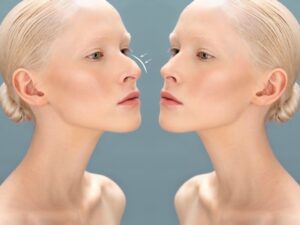
The nose is reconstructed by making a small incision in the connection area between the nostrils.
How is closed rhinoplasty performed?
In closed rhinoplasty, no intervention is made from the outside of the nose, including the area between the nostrils. All changes are performed by entering through the nostrils.
What is ultrasonic rhinoplasty?
The process of cutting and shaping the nasal bone and cartilage with very thin pen-like instruments without damaging the soft tissues is called ‘Ultrasonic Rhinoplasty’.
What is tip plasty (nose tip plastic surgery)?
The surgery applied in cases where the deformity in the nose is only at the tip of the nose is called ‘Tip Plasty’. Tip plasty is applied to people who do not have problems with the nasal bone and are only bothered by the width or height of the nasal tip. In some cases, even if the back of the nose looks arched, the problem can be solved by lifting only the tip of the nose. In such patients, tip plasty is sufficient.
Am I a suitable candidate for rhinoplasty?
People who are 18 years of age and older and physically healthy can undergo rhinoplasty.
What are the risks of rhinoplasty?
Risks such as bleeding, infection, anesthesia-related problems can also develop after rhinoplasty.
What should I do before rhinoplasty?
Medications: It is recommended to stop taking certain medications such as blood thinners and painkillers before surgery.
Smoking and alcohol: It is recommended to stop smoking and drinking alcohol one week before surgery.
Step-by-step surgery process
Anesthesia: General anesthesia
Surgical procedure: The surgery is performed with the technique your physician deems appropriate.
What should I expect after rhinoplasty?
There may be swelling in the nose and bruising around the nose after surgery. If your physician deems necessary, a tampon is placed in the nose.
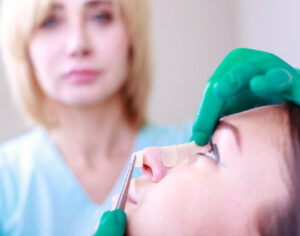 How long does the nasal tampon stay after rhinoplasty?
How long does the nasal tampon stay after rhinoplasty?
In patients with tampon application, the tampon is usually removed within 3 days.
Will there be bruising on the face after rhinoplasty?
Bruises are on and around the nose and regress quickly with ice application in the early postoperative period.
Is there any pain after rhinoplasty?
There is no severe pain. A very good pain management is possible with painkillers.
What should I pay attention to after rhinoplasty?
- Ice application on the eyes for 10 minutes every hour for the first 48-72 hours should be done.
- Physical activity should be avoided for 5 days after rhinoplasty.
- You should rest with your head elevated.
- Excessive facial expressions and laughter should be avoided for a week.
- High-factor sunscreen should be used till the bruises disappear.
- For 6 months after the surgery, the nose should not be exposed to any negative situation such as a blow to the nose.
How long should I rest after rhinoplasty?
Home rest is recommended for 5 days after rhinoplasty.
How long after rhinoplasty can I return to work?
The ideal time to return to work after rhinoplasty with major corrections is 15 days after the operation. However, if there are minor changes, you can return to work after 7 days, but strenuous activities should be avoided.
What is the recovery time after rhinoplasty?
Within 5 to 7 days after rhinoplasty, most of the swelling in the nose resolves. The swelling may take 6-12 months for people with thin skin and up to 12-24 months for people with thick nasal skin.
Frequently Asked Questions
Since the nose is the most prominent organ of the face, its shape is one of the most influential factors determining the overall character and elegance of the face.
Visually, the nose should have a triangular form. Rhinoplasty aims for a natural appearance that is compatible with the person’s facial structure.
The reasons that disrupt the ideal shape of the nose and its harmony with the person’s face are bone structure, excess soft tissue under the skin and nasal skin thickness. Depending on these, the nose may appear large.
Changes in the skin and cartilage structure of the nose cause a change in the shape of the nose over time. This is not growth in the real sense; it is part of the natural aging process. For example, with aging, the skin of the nose becomes thinner and loses its elastic structure, the tip of the nose drops, and the cartilage structure becomes very thin and may even separate.
The bone structure, excess soft tissues under the skin and nasal skin thickness which makes your nose look big may be corrected with rhinoplasty.
Rhinoplasty can correct deformities in the nose.
A nasal bone spur (hump) is caused by the bone and cartilage structure on the dorsum of the nose.
Rhinoplasty can get rid of your nasal bone hump.
As a natural part of the aging process, the cartilage structure becomes thinner, the skin loses its elasticity and the tip of the nose sags. This gives the impression that the tip of the nose is growing.
Tip plasty can correct deformities of the tip of the nose.
The nose can be shaped with rhinoplasty. If necessary, tip plasty can also be applied to the tip of the nose.
With rhinoplasty, the width of the nostrils can be adjusted as desired.
Only the tip of the nose can be changed with tip plasty which is applied to people who do not have any problems with the nasal bone and are only bothered by the width or low nasal tip.
The formation of a curvature of the structure that divides the nasal cavity into two, the upper part of which consists of bone and the lower part of cartilage, is called ‘septum deviation’. Severe deviation can cause breathing problems.
Deviated nasal septum can occur as a result of the bone or cartilage tissue in the nasal septum developing at a different rate during growth or as a result of trauma to the nose such as falls or bumps.
Curvature of the nasal septum (septum deviation) can be detected after an examination by your physician.
Since a crooked nose requires a major repair, it can be corrected with open rhinoplasty.
Yes, deviated septum can be corrected with rhinoplasty, especially in cases where it makes breathing difficult.
Yes, you can. Rhinoplasty is both an aesthetic and a functional surgery.
The appearance of the nose is one of the most effective factors that determine the general character and elegance of the face. Even some minor corrections to the nose which is the most prominent organ of the face can change the facial appearance a lot.
Since rhinoplasty corrects the deformities in the nose and thus ensures the harmony of the nose with the face, the person will look more attractive, elegant and young.
Rhinoplasty is performed when the facial bones are fully developed, that is, after puberty, at the age of 18 and above.
There is no upper age limit for rhinoplasty.
Which type of rhinoplasty you need is determined after your physician’s evaluation. In general, open rhinoplasty can be applied if major changes are required in the nose, but closed rhinoplasty can be applied if smaller changes are sufficient.
Your physician will examine your nose in detail. Photographs of your face are taken from various angles. The nose shape to be created in accordance with the face type is decided and this is shared with you.
Smoking and alcohol should be stopped one week before the operation. Drugs that increase bleeding such as blood thinners and painkillers should be stopped beforehand according to your physician’s recommendations.
Since smoking will have a negative effect on tissue healing, it should ideally be stopped one week before.
Yes, it is possible. In closed rhinoplasty, no incision is made on the outside of the nose, but you must be a suitable candidate for closed rhinoplasty.
Since rhinoplasty is performed under general anaesthesia, no pain is felt during the operation. Painkillers are given for the first few days after the operation. Rarely, stronger painkillers may be required on the first night.
Bruising on the face after rhinoplasty resolves by 50% in the 1st week and completely disappears in 2-3 weeks.
Swelling in the nose may gradually increase in the first 3 days after rhinoplasty. It is recommended to keep the head in an upright position to reduce swelling.
Medications used after rhinoplasty, ice application in the early period and keeping the head in an upright position allow the swelling to regress faster.
The purpose of the splint applied on the nose after rhinoplasty is to protect the operation site from any traumas. The splint is removed one week after rhinoplasty.
If you have stitches that need to be removed after rhinoplasty, it is appropriate to remove them after a week. Since the stitches applied into the nose dissolve on their own over time, they do not need to be removed.
Removing the nasal tampon applied into the nose during rhinoplasty is not a painful procedure.
The nasal tampon is kept for a maximum of 3 days.
Immediately after the operation, tampons are inserted into the nose and remain for the first night. Since the tampons are often made of silicone, breathing through is not very difficult. When the tampons are removed the next day, you will start to breathe more easily. Since the crusts in the nose will be removed after the first week by rinsing the nose with salt water and blowing it gently, you will be able to breathe more easily.
The nose is cleaned with the solution recommended by your physician for 1-2 weeks after rhinoplasty. Nostrils should not be rubbed while cleaning the nose. After the nasal tampon is removed, inside of the nose can be cleaned several times a day with a soaked ear swab.
For the first 3 days after rhinoplasty, you can take a shower with warm water, avoiding getting water into the nose.
You can wash your hair in the same way as applied in hairdressers for the first 3 days, with your head thrown back well, so that no water gets into the nose. Afterwards, there is no harm in taking a normal shower with warm water.
The nasal area should be protected from traumas and the sunlight. Carelessly cleaning the inside of the nose may cause bleeding. In addition, alcohol and smoking should be avoided since they delay wound healing. Lying flat should also be avoided.
For the first 5 days, the head should be upright with the support of 2-3 pillows.
If you lie on your side after rhinoplasty, the nose will touch the pillow uncontrollably, causing damage to the surgical area. In addition, swelling under the eyes and in the nose will not heal.
You can lie on your side 2 weeks after rhinoplasty.
Sneezing after rhinoplasty can damage the nose. Increased intraabdominal pressure during sneezing can damage the surgical site.
If you have to sneeze, it is recommended to sneeze with your mouth open.
Blowing your nose increases the pressure inside the nose. This can damage the surgical site. It is not recommended to blow your nose for a week after rhinoplasty.
You can do housework 3 weeks after rhinoplasty.
The ideal time to return to work after rhinoplasty with major corrections is after 15 days. However, if there are minor changes, you can return to work after 7 days, but strenuous activities should be avoided.
You can drink alcohol 1 week after the operation.
You can start all kinds of sports after 1 month. However, the nose area should not be hit, especially for the first 6 months.
You should be protected from the sun for 2-3 months after rhinoplasty. Sun cream with a factor of at least 30 SF should be used to cover the area under the eyes and nose.
Wearing a mask is not recommended after rhinoplasty as it causes pressure on the nose.
It is recommended not to wear glasses for an average of 2-3 months depending on the degree of changes made to the nose.
Swelling in the nose decreases 80% in the 3rd month. In the 6th month, 90% of the shape of the nose becomes clear. At the end of the first year, the nose takes its final shape.
It takes an average of 6-12 months for the nose to take its permanent shape after rhinoplasty. This period extends up to 24 months for those with thick skin structure.
The results of rhinoplasty are permanent. Only some changes that depend on the natural aging process of the person may occur over time.
Infection and bleeding, which can occur in every surgical operation, can be seen very rarely.
The surgery performed when the desired aesthetic look of the nose or improvement in breathing cannot be achieved after rhinoplasty is called ‘Revision (Correction) Rhinoplasty’.
If there is no emergency, revision rhinoplasty can be performed at the earliest 6 months after rhinoplasty and 1 year after rhinoplasty if it is possible to wait.
Revision rhinoplasty is not more difficult for you than the first operation. The difficulty is more for your physician who will perform the surgery. The difference for you is that there will be a second wound area only in cases where there is not enough cartilage tissue in the nose, as ear or rib cartilage must be removed.
The process of cutting and shaping the nasal bone and cartilage with very thin pen-like instruments without damaging the soft tissues is called ‘Ultrasonic Rhinoplasty’. However, it is a method that can only be applied during open rhinoplasty.
For people who do not want to have surgery, mild deformities in the nose and, if necessary, a low nasal tip can also be eliminated with tissue fillers and, if necessary, botox applications can be applied under local anaesthesia.
Mild irregularities in the nasal bone can be corrected by application of tissue fillers.
Firstly, a good planning should be made, as in rhinoplasty. Then, numbing creams and sometimes local anaesthetics are applied to the nose. The nose is then reshaped by injecting tissue filler into the previously planned areas. If a change is desired at the tip of the nose, a small amount of botox is injected to the tip of the nose.
Tissue fillers may be applied to patients who do not want to undergo surgery; who have undergone rhinoplasty, but complain of simple irregularities that require correction; who have a low nasal tip; who have asymmetry in the alas of the nose; who have small irregularities; whose nasal shape is suitable for this application and who have never undergone any intervention before.
Hyaluronic acid is mostly used as a tissue filler for the nose. Botox injections may also be performed as an auxiliary filler.
The effectiveness of tissue fillers used lasts 8 to 12 months. After one year, if the patient wishes, it can be applied again.
If you are using blood thinners, you should stop them 5 to 7 days before the procedure. You should avoid excessive physical activity on the day of application. You can return to your daily activities immediately after the application.
Non-surgical rhinoplasty is a fast and reliable procedure with immediate results. It can be applied in an outpatient setting. There is no scar and no bandaging is required. You can return to work immediately after the procedure. However, you should inform your physician if there is any unexpected pain or swelling.

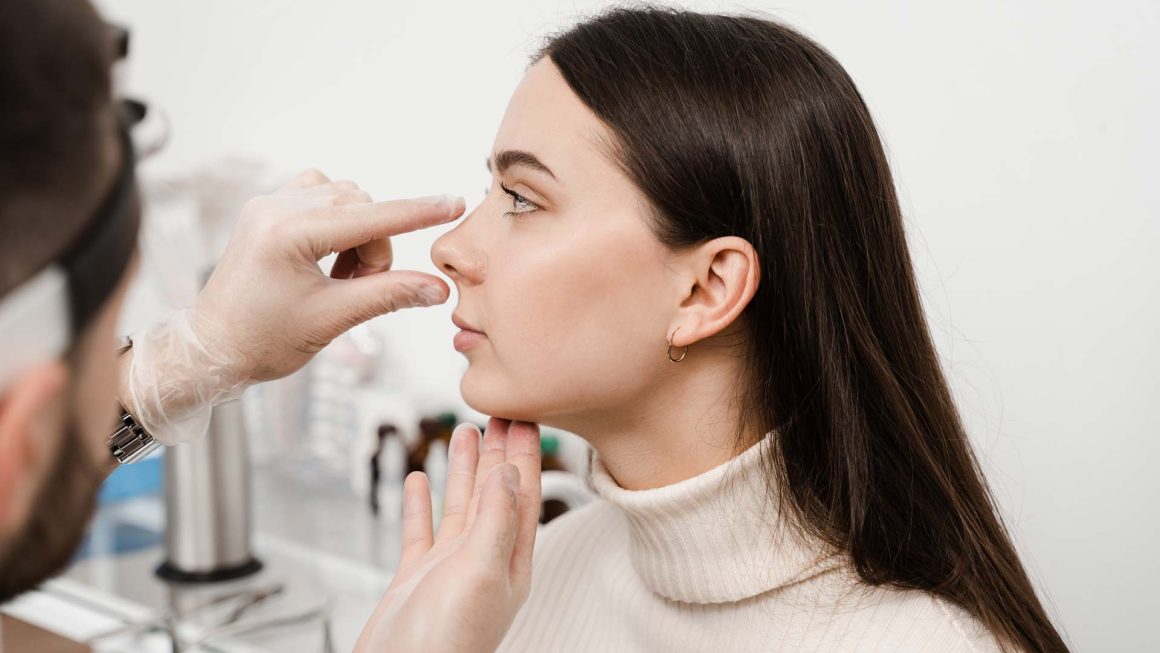
Leave a Reply
You must be logged in to post a comment.